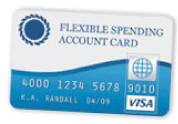CARL WATTS & ASSOCIATES
October 25, 2010

|
Washington DC
|
tel/fax 202 350-9002 |
Flexible Spending Account

|
The dictionary says: “a flexible spending arrangement (FSA) — commonly known as a flexible spending account — is one of a number of tax-advantaged financial accounts that can be set up through a cafeteria plan of an employer in the US.”
 |
|
|
In earlier times, plans that allowed employees to choose between different types of benefits were called cafeteria plans simply because they were compared to the ability of a customer to choose among available items in a cafeteria, thus flexible.
|
|
|
FSAs can be a good idea if you know how to take advantage of them. But let’s not get ahead of ourselves and take things in a proper order.
|
|
|
FSA is an employer-sponsored benefit that allows you to pay for eligible medical expenses or dependent care expenses on a pre-tax basis.
|
|
|
Employees from any business, government or not-for-profit organizations may have a FLEX plan. Even most partners in a partnership may participate, except for sole proprietors.
|
|
|
If you expect to have medical expenses that won’t be reimbursed by your regular health insurance plan or expect costs of caring for legal dependents, you should take advantage of your employer’s FSA if it is offered. And how does that happen?
|
|
|
At the beginning of a plan year (usually January 1st) during an open enrollment period, your employer may give you the opportunity to participate in a FSA program and ask you how much money you want to contribute for the year, within certain limits.
|
|
|
That amount is taken out of your paycheck in equal installments each pay period and placed in a special account.
|
|
|
The amount you contribute is excluded from your income, thus lowering your federal and state taxes.
When you have medical expenses not fully covered by your insurance, you submit |
|
|
a copy of the Explanation of Benefits of the provider’s invoice and proof of payment to the plan administrator who then issues you a reimbursement check.
|
|
|
Why would an employer offer you an FSA program; you may ask. It is a benefit for employees at no additional company expenses and the amounts contributed to an FSA program lower the taxable payrolls as well.
|
|
| The Health Care Flexible Spending Account allows you to set aside an amount within the maximum amount determined by your employer to cover medical expenses like: co-payments for doctor visits, some uncovered dental expenses and prescriptions. Most over-the-counter medications and chiropratic services are no longer allowed. It cannot pay for health insurance premiums, cosmetic items and surgery or controlled substances. |
|
| If you itemize deductions on your tax return but your typical medical expenses don’t exceed the deductible percentage threshold of 7.5% of Adjusted Gross Income, than the FSA can offer great tax savings. Another advantage is that you can use the money you agreed to place in the FSA before it’s all paid in. |
|
| The most important drawback is you need to carefully figure out your estimated out-of-pocket expenses, because there is no rollover, and the rule is if you don’t use it you lose it. |
|
| Some employers choose to issue a debit card to their employees who participate in the FSA so that they can pay for the FSA-eligible expenses at the point of sale. |
|
|
|
|
| The Dependent Care Flexible Spending Account can help you provide physical care for small children (under 13) or dependent adults who can’t take care for themselves. Services covered include child or elderly day care, day camp, in home care. |
|
| The dependent care FSA is federally capped at $5,000 per year and is not “pre-funded”, meaning you cannot receive reimbursement for the full amount of the annual contribution on day one. The dependent care FSA also obeys the rule “use it or lose it”. In recent years Child and Dependent Care Credits have become more attractive than dependent care FSAs, especially for those having more than one dependent in care or those with very low income. |
|
| Although less common, some employees offer adoption assistance through an FSA. |
|
|
The new health care legislation includes provisions that will cap the amount that can be put into FSAs at $2,500 per employee, down from $5,000 today, effective as of 2013.
|
|
| If you do have unreimbursed medical expenses or dependent care expenses, it might really be worthwhile to take the time and talk to your employer to find out what FSAs they can offer, calculate carefully what amount of savings is right for you personally, and if necessary, talk to a professional for advise as well. |
|
|
And of course, keep in touch with us!
|
|